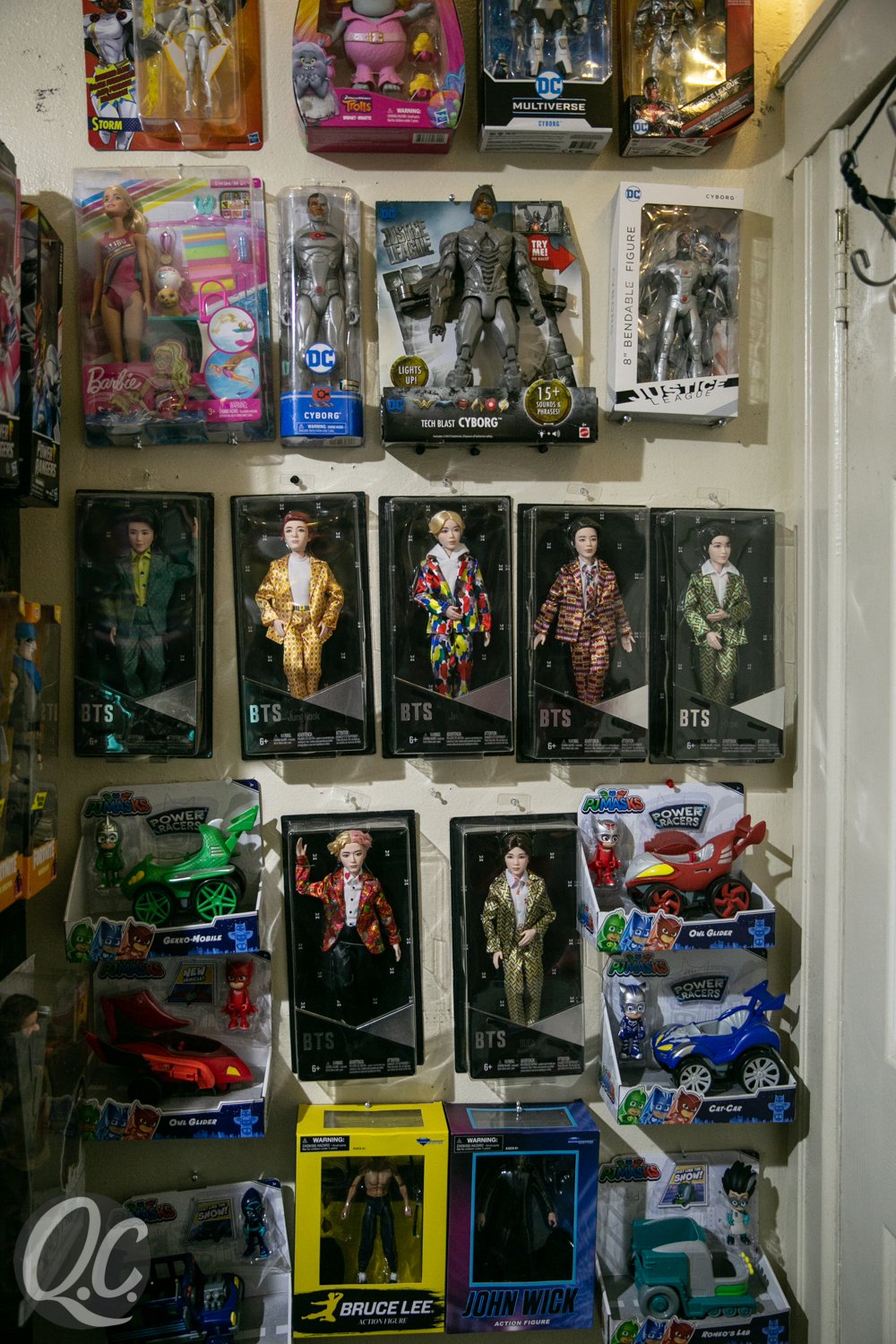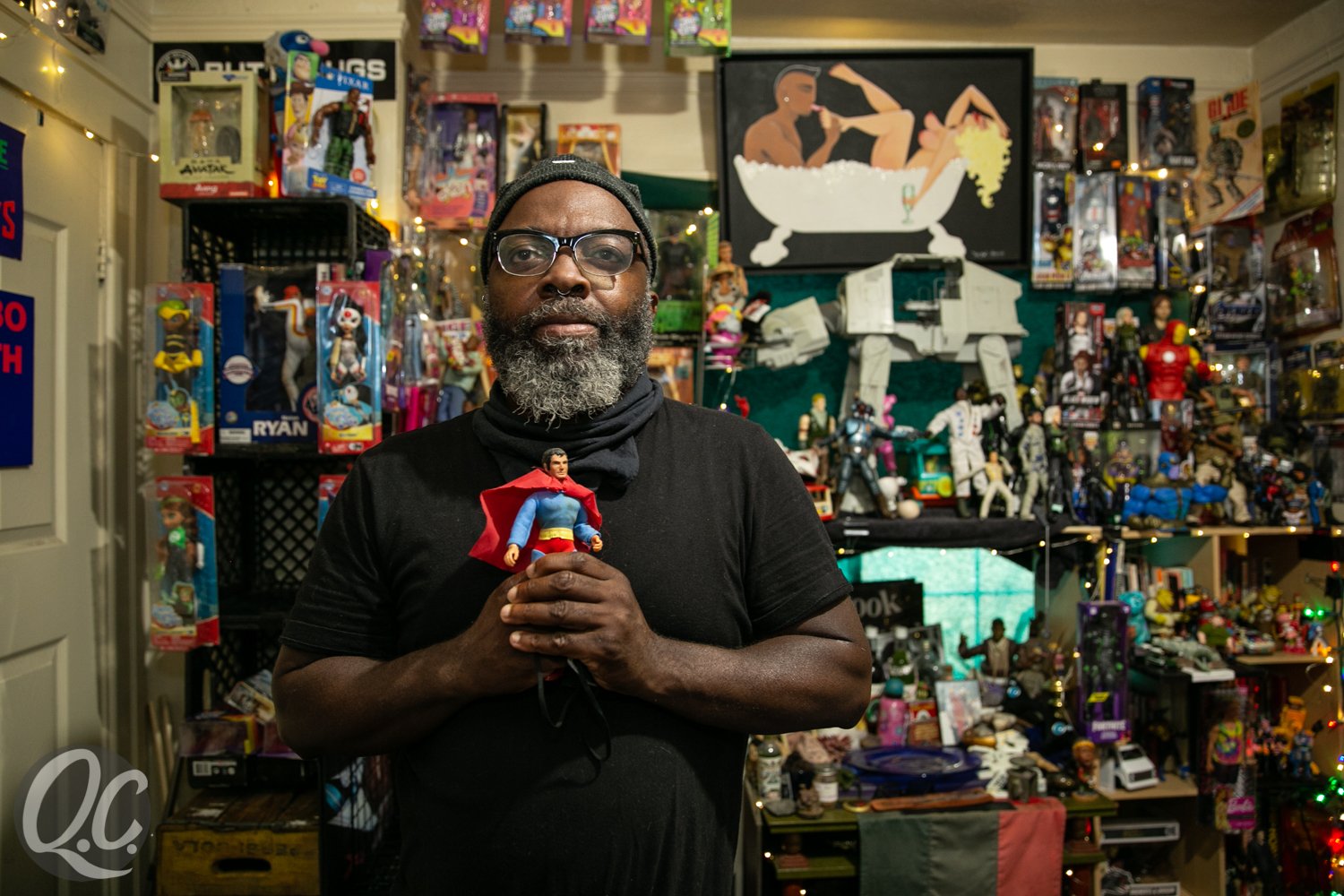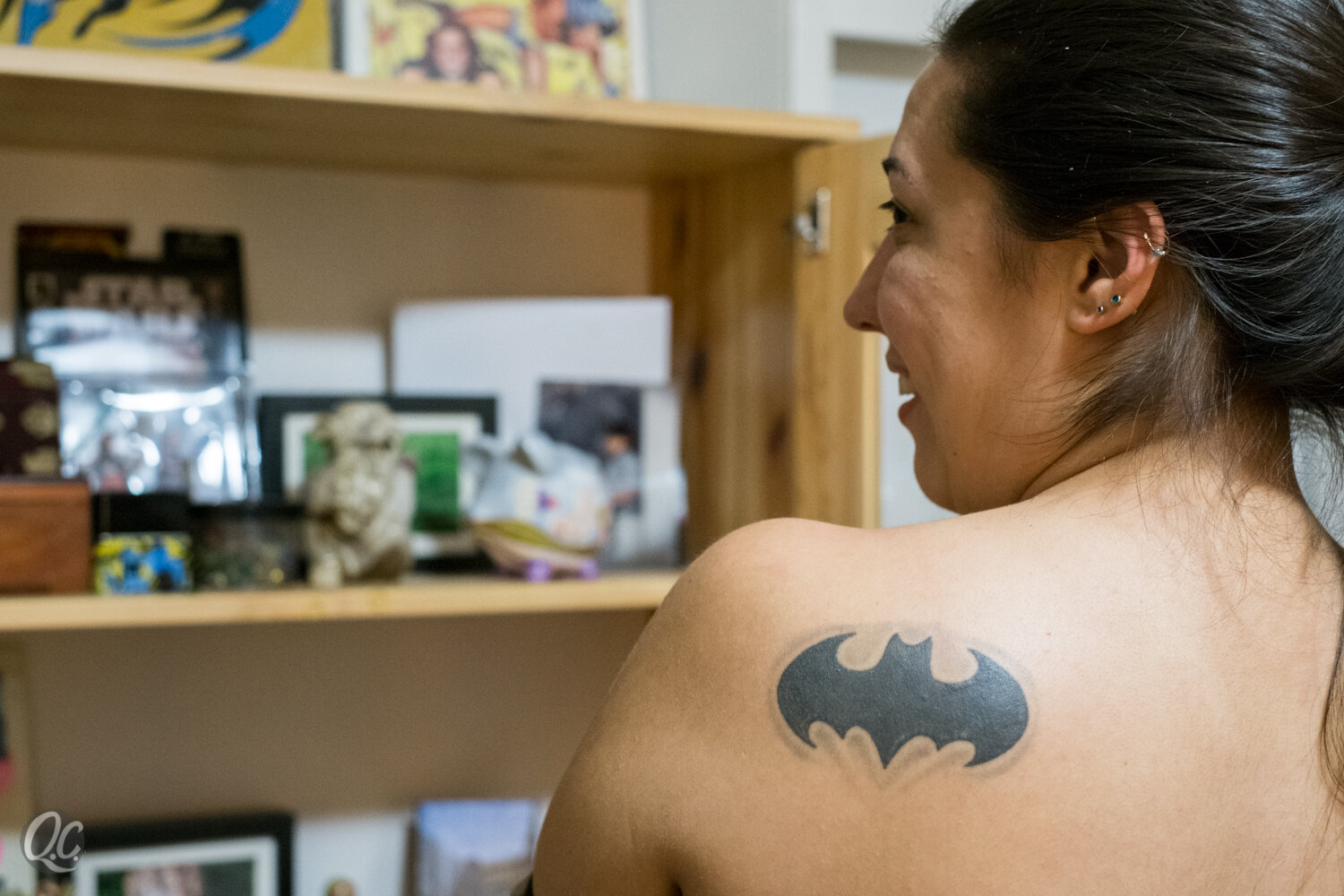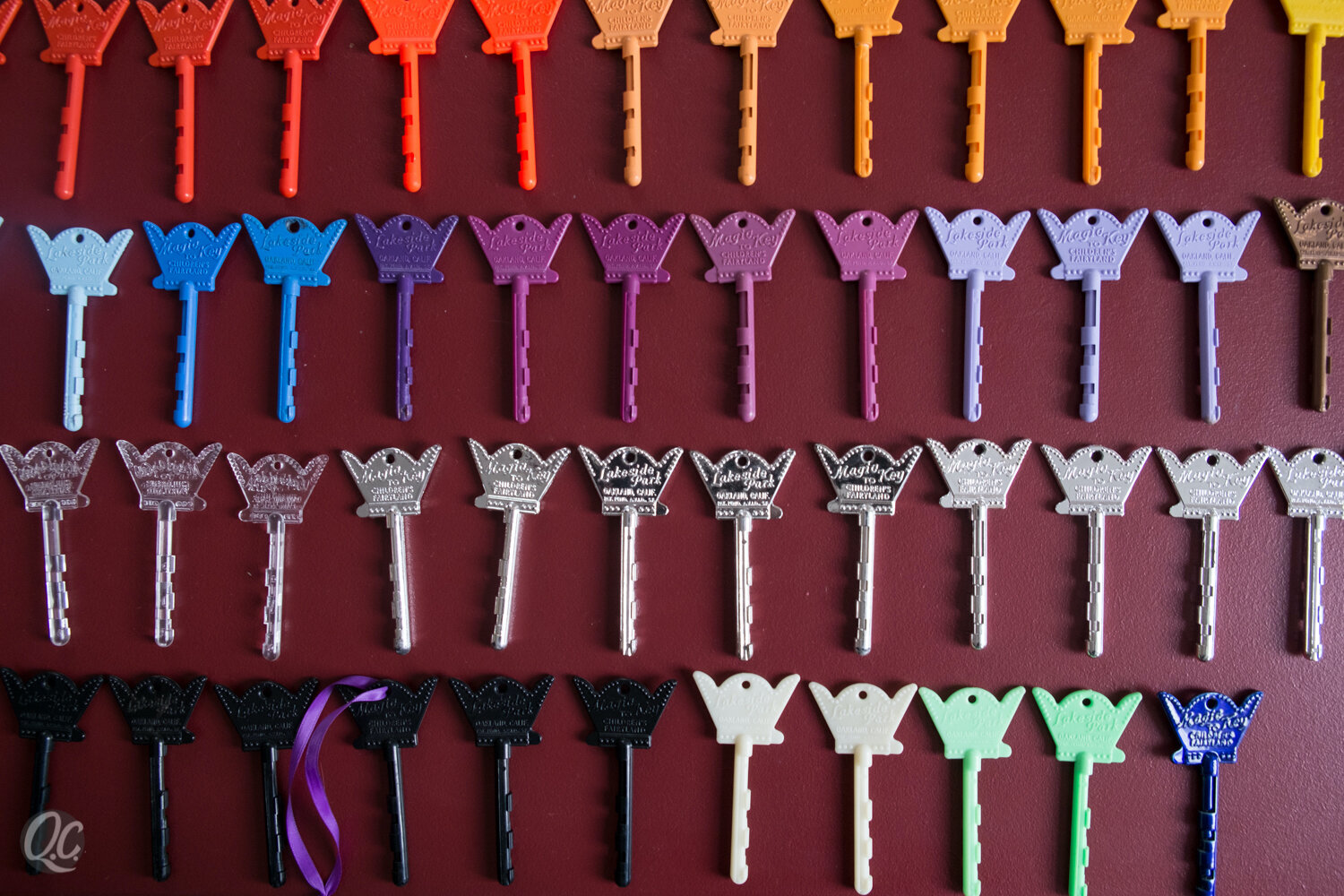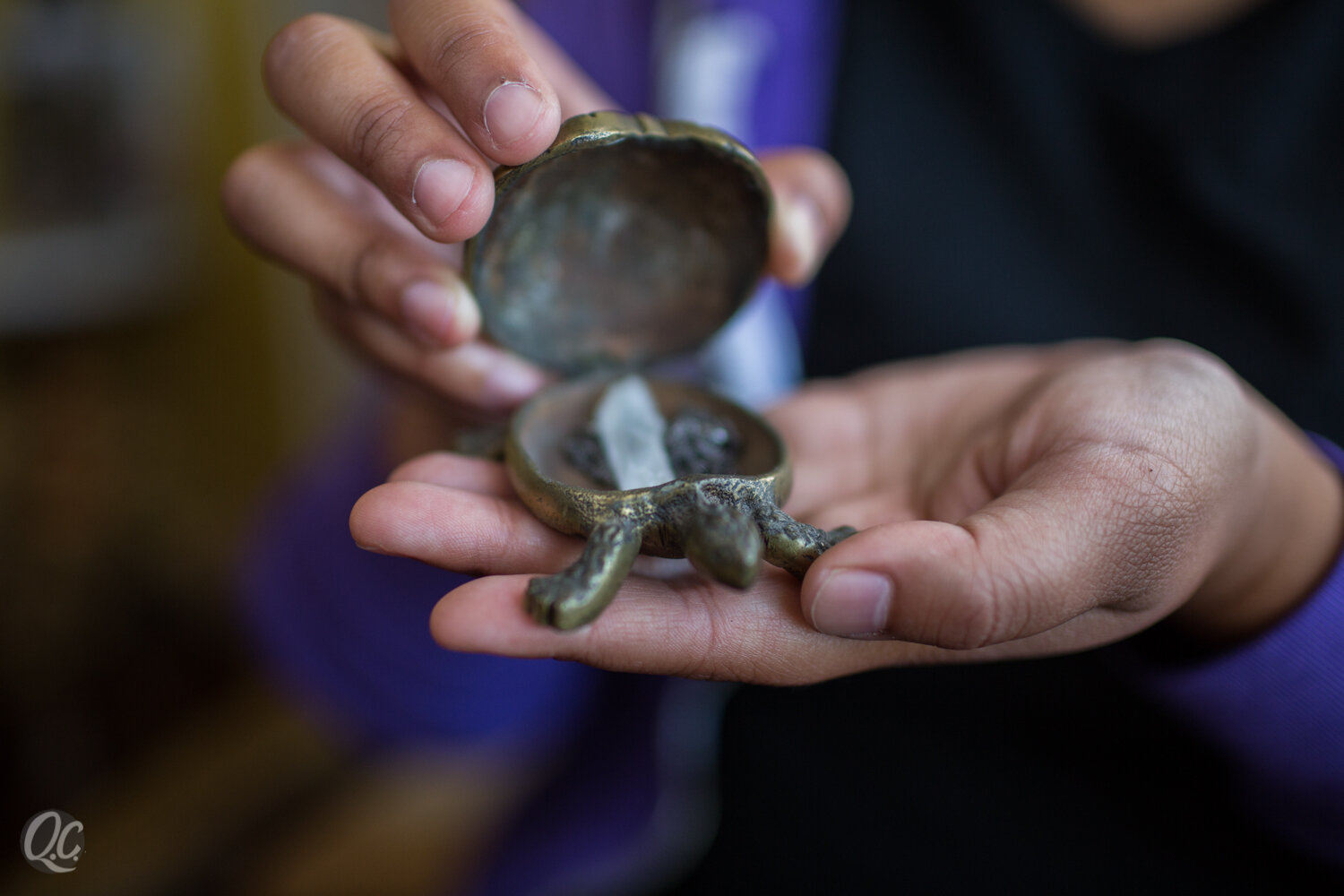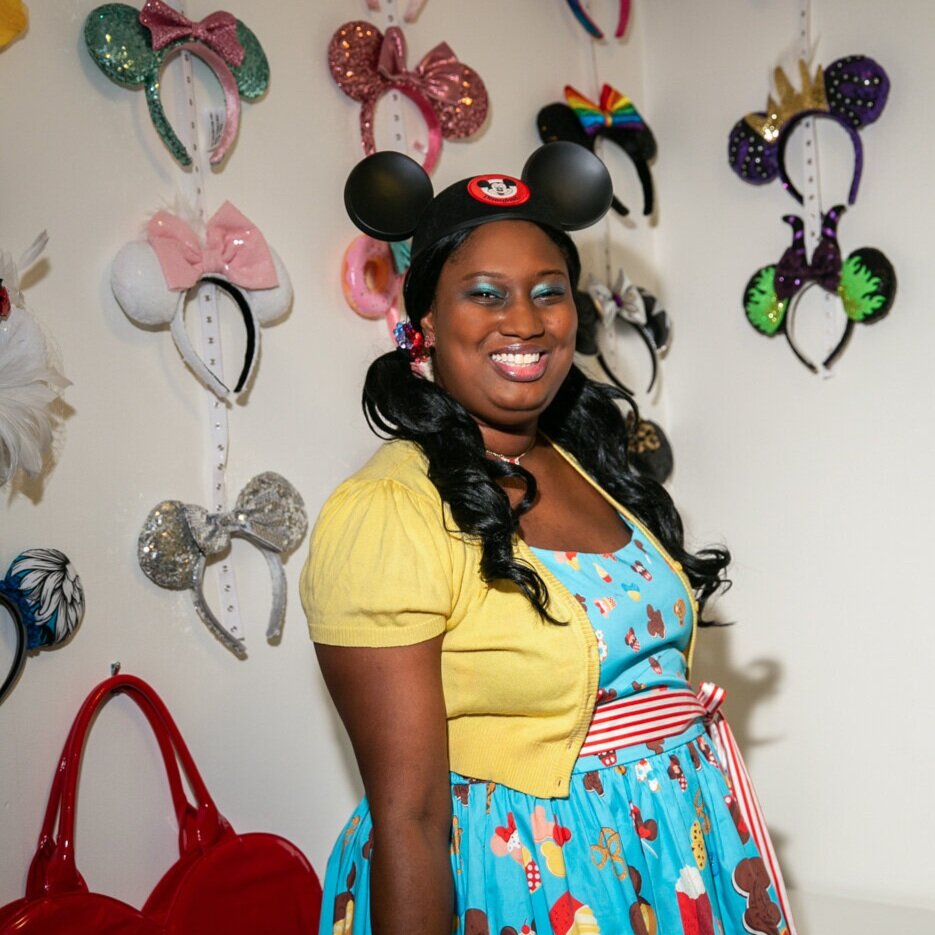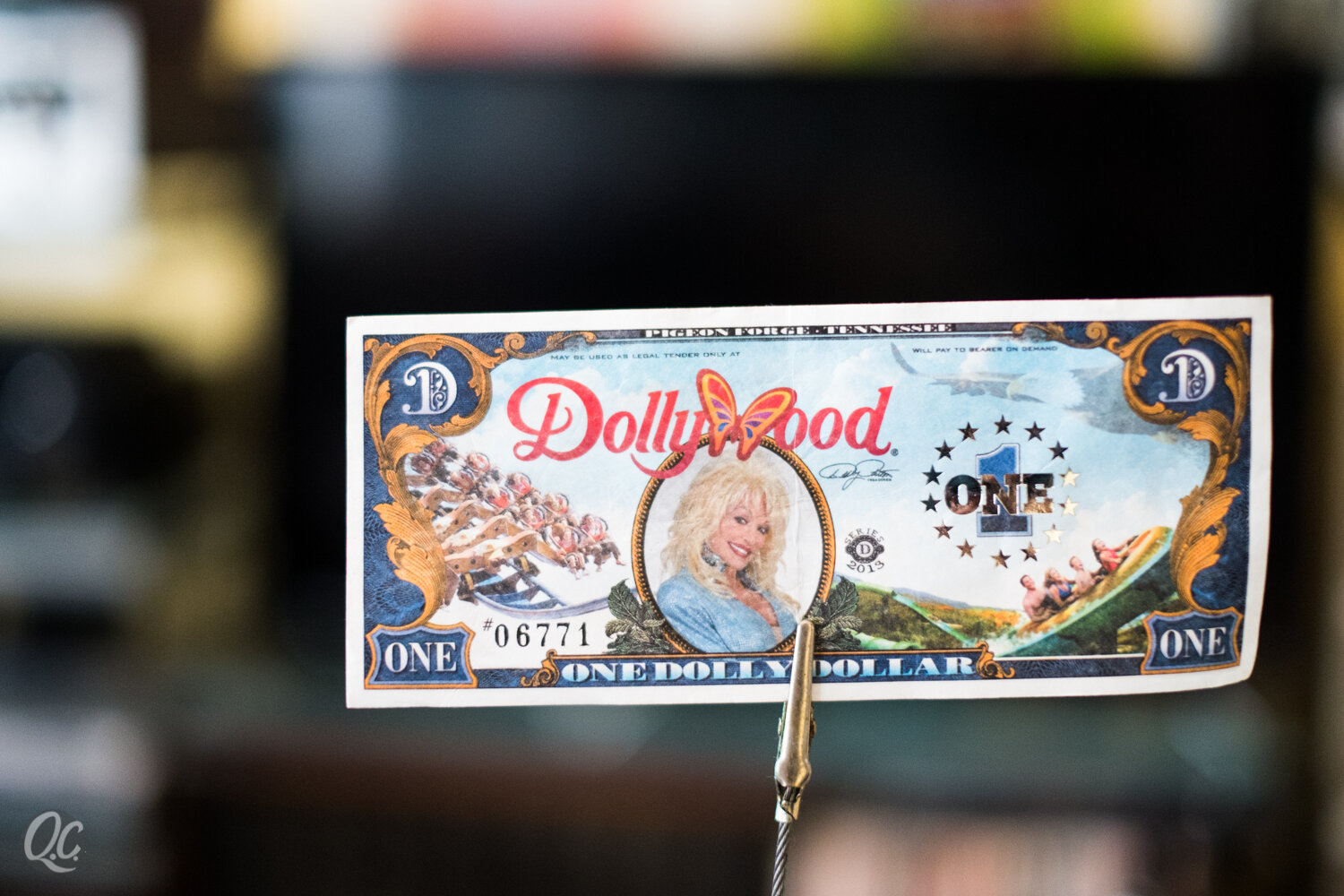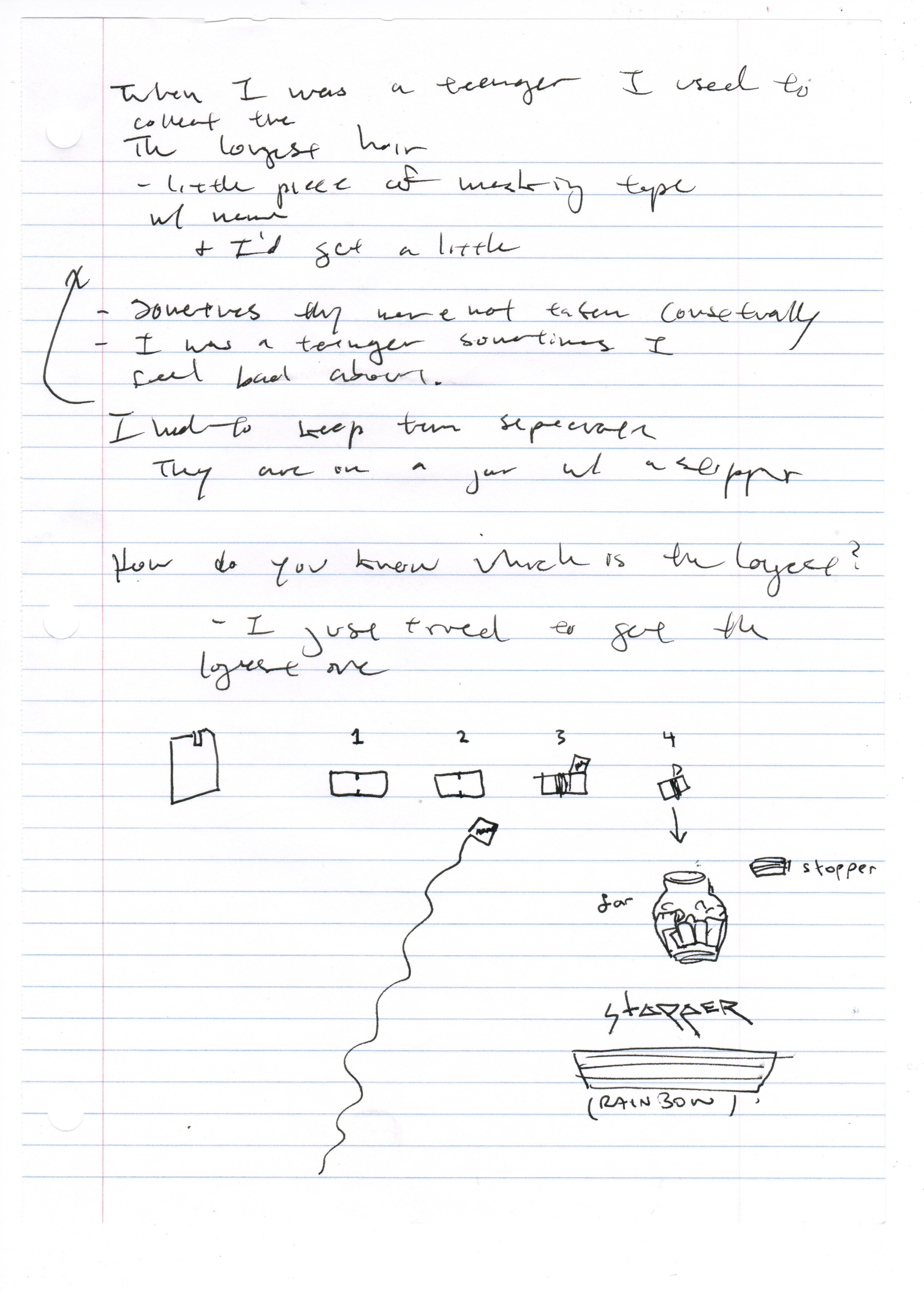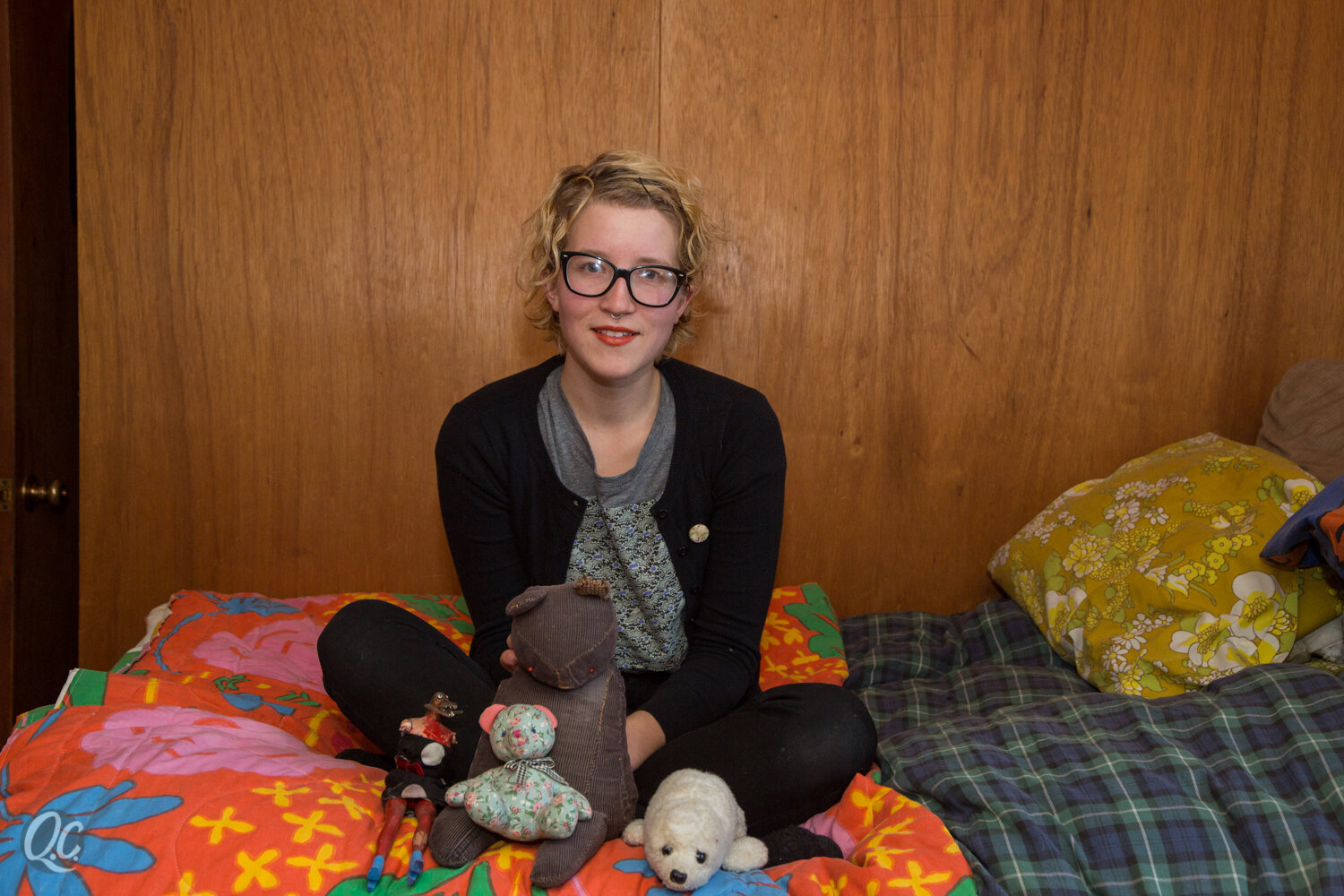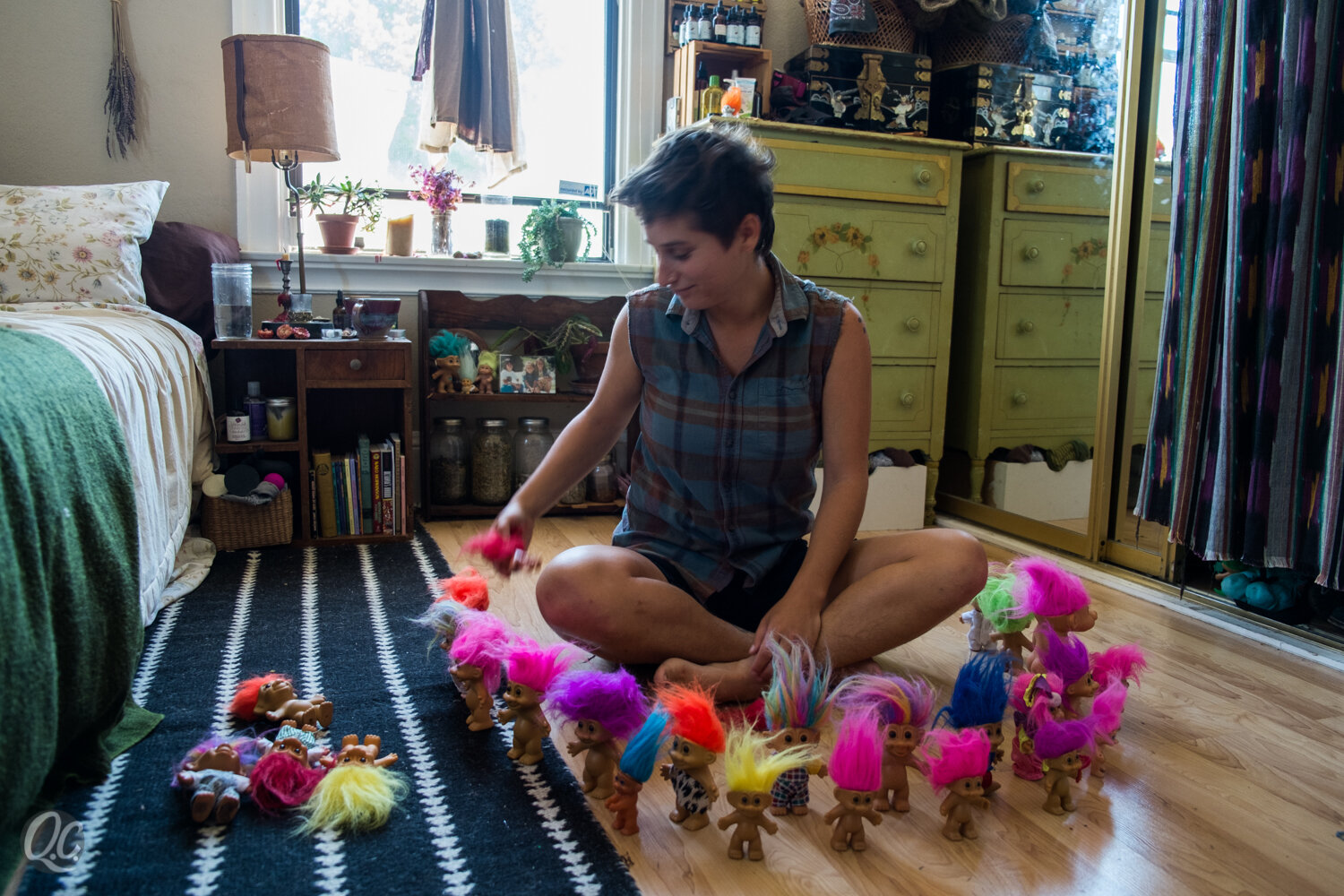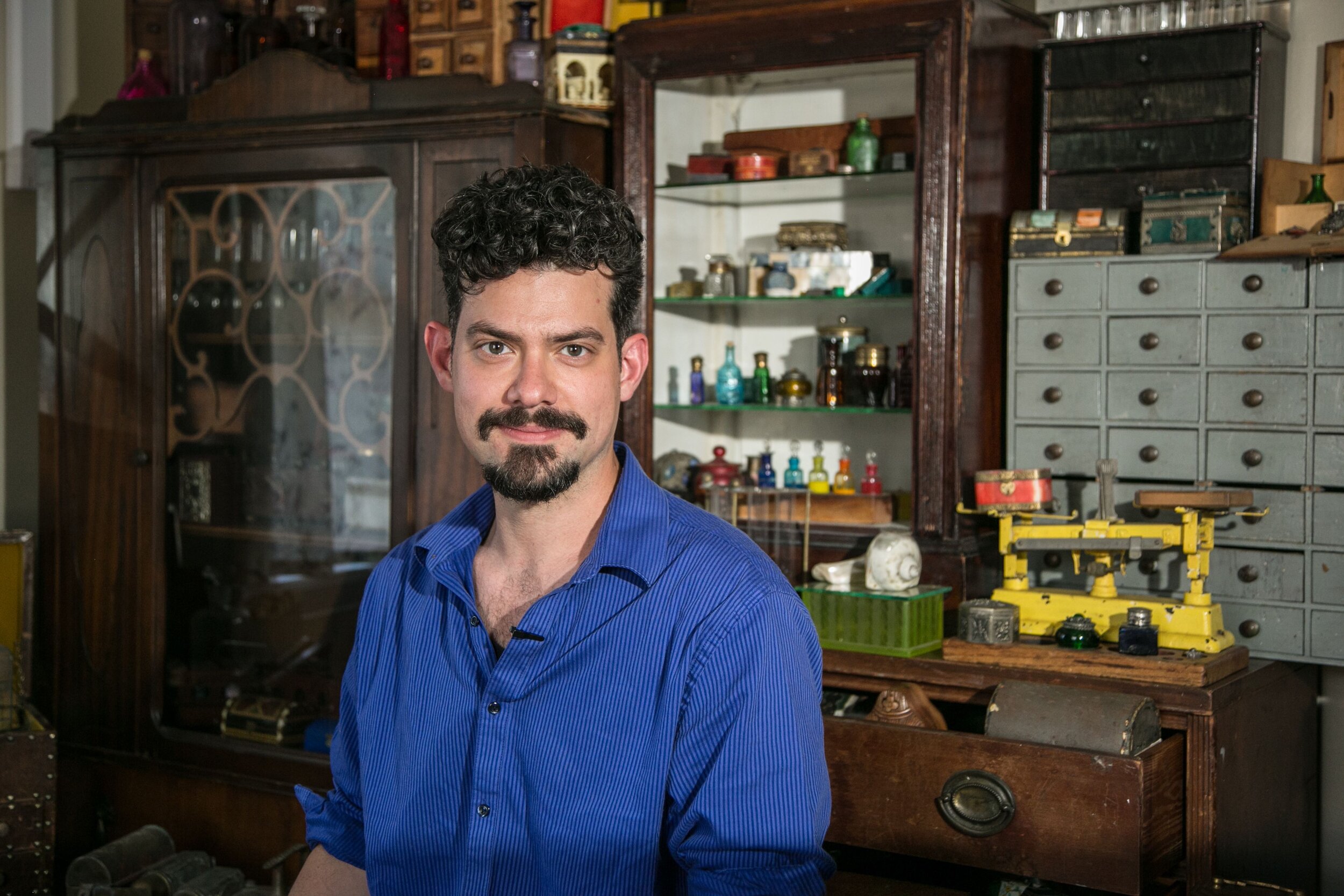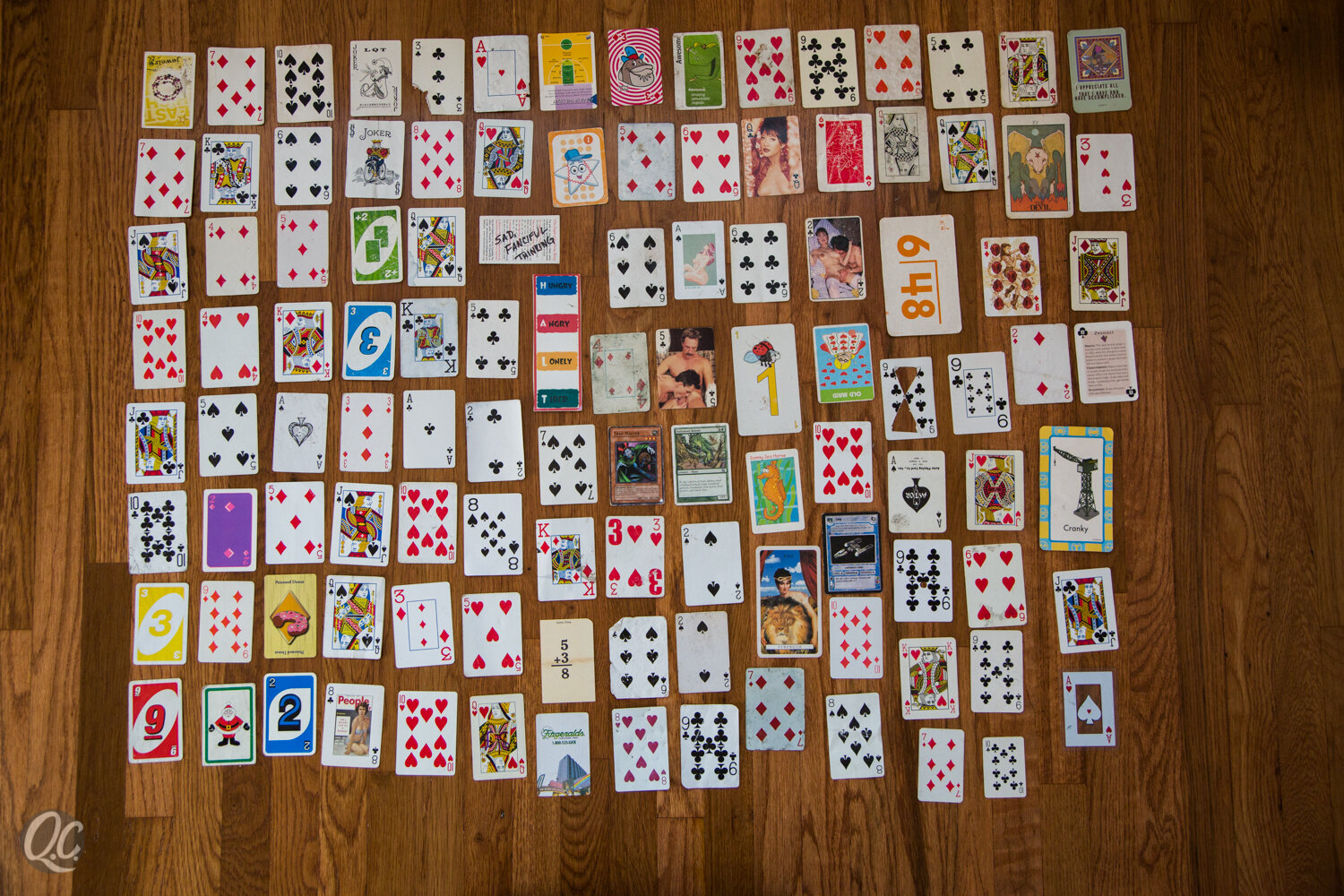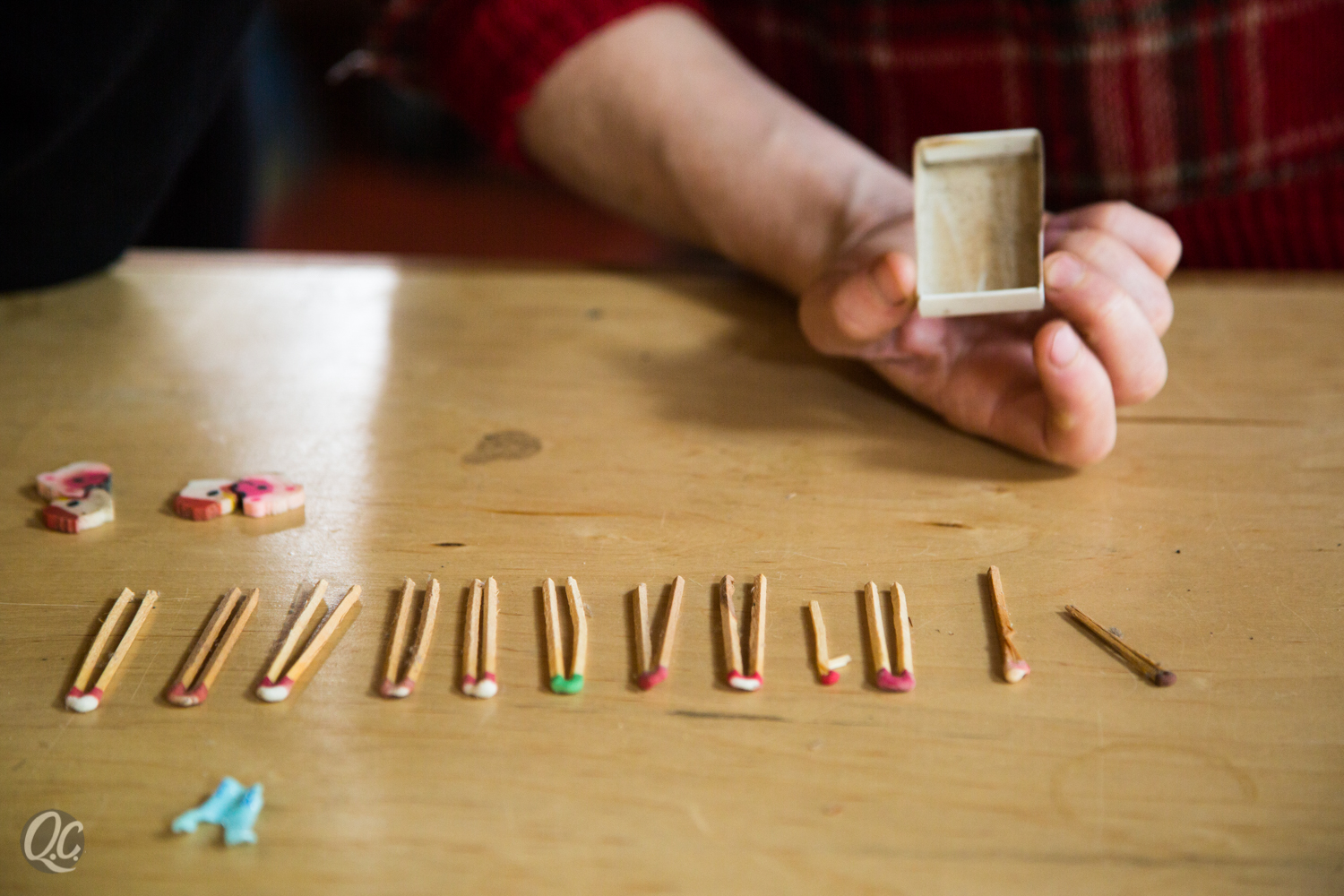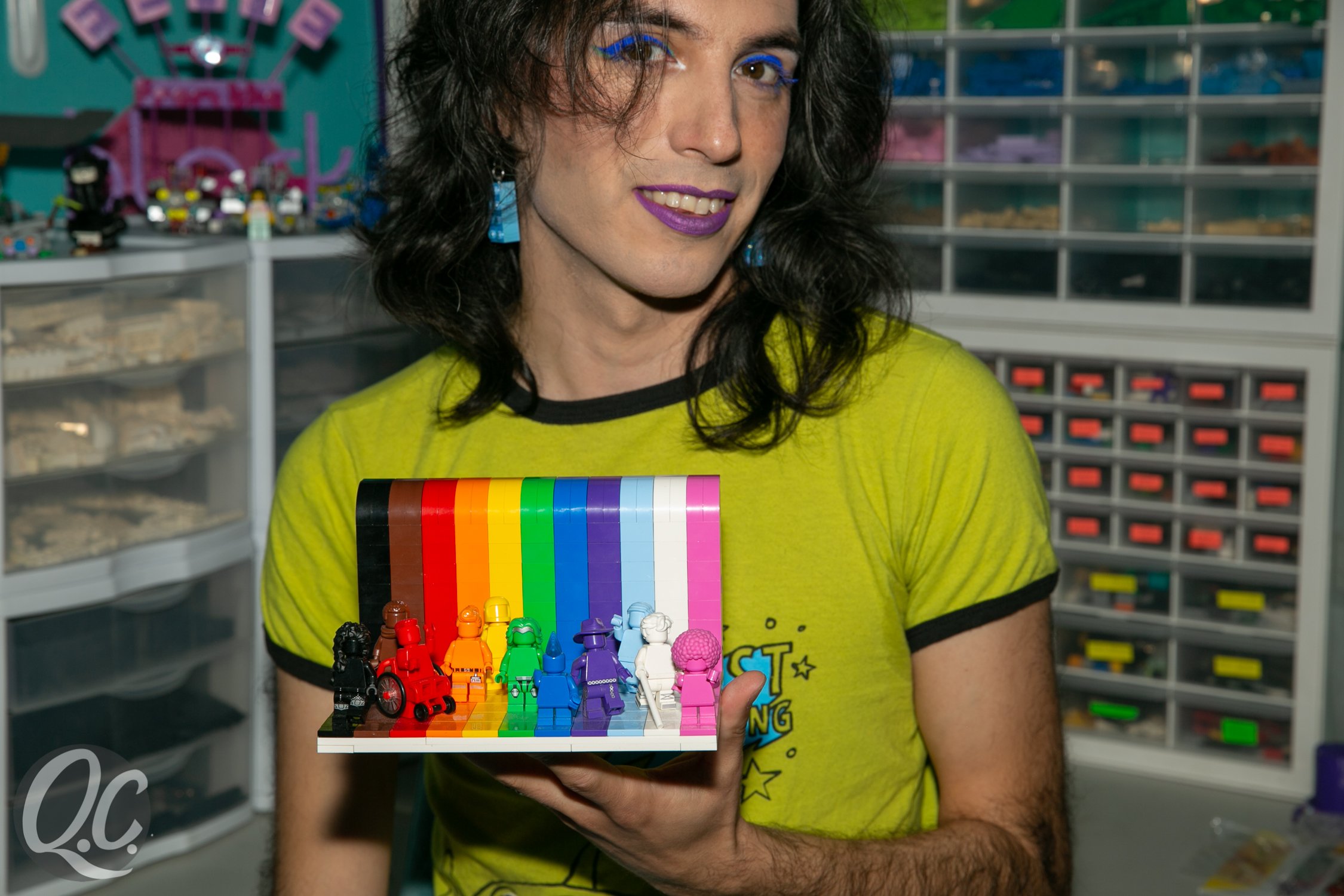Juba Kalamka & the Wall of Dolls
Juba stands in front of a wall lined with dolls, Barbies and other sculpts.
Juba & The Walking Dead
JUBA: When I was working for AIDS Healthcare Foundation, I had a patient who I was working with. He says, "You have a lot of dolls." I said, “Yeah." And he says to me, he says, “Do you think when you leave at night that they talk to each other?" And I said, “You know, I never thought about that," but, I didn't say, "You wigging me the fuck out {smile}."
ZOE: You have the office all decked out then?
He said. “I think you want to peep it. Cause you work in HIV services. At the end of the first season, they blow up the CDC.”
JUBA: There were dolls on my desk and there was a shelf.
ZOE: Do you feel like that helped the clients you worked with feel more at ease?
Old photograph of Juba’s wall at AHF featuring dolls. *image courtesy of Juba Kalamka
JUBA: Absolutely did. I had dozens of people who came through either for HIV testing or with partners for serodiscordant {HIV-negative} stuff or people who were patients who were coming for just different lateral advocacy stuff. I found it was a way it created a space for me to have conversations with people that were casual. It made me goofy. It made me soft in this particular kind of way. People would laugh. I had a few people like burst out laughing.
A couple of things led up to my current collecting:
My wife, who is the archetype of the queer librarian works in both San Francisco and Oakland library systems. So, one day I was waiting for her to finish her shift at the Oakland Library Children's Section. I went upstairs to browse and came across the Walking Dead comic book.
I've been a zombie geek for years and years because of my sister. I've been like obsessed with Romero {director, George Romero} shit in particular, like Dawn of the Dead is my dishwashing--original Dawn of the Dead--is my dishwashing movie. I've watched that like probably upwards of a hundred times. So, I came across the comic book and I was like, "Oh, I dig this, I'm liking this. This is fresh.” I'm like, "Wow, Atlanta damn dude, this is a different angle on this shit." Right? So, I was talking to a friend about it. He said, “Yeah, man.” He said, “You know it’s a TV show, right?” I'm like, “For real? That's going to be some garbage. They ain't gonna put enough money in it and do it right.” He's like, “Nah, man, they did. They spent some money on it. Peep it,” he said. “I think you want to peep it. Cause you work in HIV services. At the end of the first season, they blow up the CDC.” I say, “Oh shit.” I'm like, "I gotta watch this shit." Right? So, I watch it. I become obsessed with it.
The race and gender stuff became having conversations around whiteness and non-whiteness and understanding whiteness as a social construction, and how that's navigated in the creation of action figures and dolls.
They have two sets of action figures. One is based on the comic book iteration. The other is based on the television show. I really wasn't terribly into the comic book ones, but McFarlane Toys who did all the Spawn toys some years ago -- developed the TV versions. There's all kinds of really cool sculpts. I saw them and thought “these are nice". So, I started collecting those figures.
Daryl from The Walking Dead still in packaging. *image courtesy of Juba Kalamka
Juba Kalamka displays a Mego 2-XL, a toy from his childhood purchased by his mother at the DAV thrift store for $5.
Sculpts are the actual sculptures done of characters in a comic or actors portraying characters in a film. The good quality sculpts make better figurines. In the case of The Walking Dead, the figures actually look like the actors in the show. This is also affected by licensing agreements that have been made with the associated properties - it costs more money to license the likeness of the actor. So often you will see figures made from TV shows and movies that don’t look anything like the performers.
A Racialized Taxonomy of Dolls
The original reason for my collecting, when I got interested in it was: What would a racialized taxonomy of dolls look like? You get into the, you know, the, what you’d call the Mongoloid/Caucasoid/Negroid phrenological or whatever it is, but also two layers of conversation around race and gender and the quality of sculpts.
The race and gender stuff became having conversations around whiteness and non-whiteness and understanding whiteness as a social construction, and how that's navigated in the creation of action figures and dolls. For example, let's take in comic books...a character like the Sub-Mariner. (The Sub-Mariner is a half human and half Atlantean character appearing in Marvel Comics since 1940. Read more about him here.)
Okay. As a mixed-race character, you know, as half Atlantean and half human, he is a non-white person. So it's like, this is, and if (the reader is) referring to him or thinking of him as a “white” person. Simply because he is “white” skinned or light skinned, they’re owning, whether they know that or not - that whiteness is a social construction that sometimes intersects or overlaps with the cultural and national experience and identity of Europeans and the slippages around “contextual whiteness”, or people identifying with the construction of whiteness, either fiercely, contextually, ostensibly or casually. And what that means in terms of relative assimilation into whiteness as a social category--and what that's meant over history.
I had a professor in my graduate Poetics program, Adam Cornford, who used the phrase “dominance category” when referring to the history and social construction of whiteness, and that became very useful to me when I started thinking more deeply about collecting. I’ve been deeply influenced by the work of Eliot K. Daughtry, a multimedia artist and co-owner of Killer Banshee Studios in Oakland with his partner Kriss deJong. Kriss and Eliot did sound and video installation work for the PeaceOUT World Homohop Festival that I booked and curated from 2002-2007, and recorded several Deep Dickollective projects, as well, as my second solo album Ooogabooga Under Fascism. A few years later I worked with them on the physical installation of Eliot’s MFA project concerning the gender taxonomy of robots.
Detail of Juba’s BTS dolls.
An unboxed Hattie doll from Gone With the Wind peers over Juba's collection of femme action figures.
The 'Sissy’shelf.
I started real simple thinking, for example, If you have a doll-say Iron Man…..you can't see Iron Man's face. You don't know who's in the suit, even though, you know, the character’s “real” identity is the industrialist Tony Stark, and Tony Stark is white. But later, in the mid 1980s, Stark’s friend and colleague, James Rhodes, becomes Iron Man. Rhodes is an ace helicopter pilot, veteran of multiple U.S. armed conflicts, super intelligent and a master combat strategist, but has to stop because the cybernetics in the Iron Man suit (the helmet gear in particular) are fucking with his brain….giving him these super migraines. And it's like, Marvel's writers not understanding what that means in terms of the racism attendant to the manner in which they coded this character’s story arc. A super intelligent Black man puts on this suit and his brain can’t handle it.
“When she opens the oven door, the spirit of the doll comes out of it, and she's possessed by the doll. Scared the shit out of me.”
ZOE: I have a question about semantics. Dolls versus action figures?
JUBA: Yeah, yeah. I very purposely say “dolls” when referring to what are most commonly commercially known as “action figures” because I tend to lump them all together - but still understanding that each name refers to what for years has been a set of very heavily policed gendered categories.
The action figure is, of course, a way to sell dolls to homophobic and/or heteronormatively acculturated parents of boys without having a conversation around their children engaging or enduring homophobic insults like the, "Ooh girl or you Ooh, gay playing with that doll", or an inverse of homophobic gender policing along with the misogyny that cis girl children have experienced around playing with G.I. Joe toys in the 1960s and 1970s. But also, what is an “action figure” is very much about the idea how the doll is a physical representation or depiction of someone who’s actions happen in a very specific domain of [primarily white] cis hetero masculine violence and power. A Barbie doll who's a cook or a chef or a teacher is an action figure. Barbie hasn’t ever been promoted as an “action figure” as such, but until very recently has functioned as sort of a (white cis feminine) ladies auxiliary in terms of upholding the aforementioned overlapping and intersecting of race and gender politics.
Early Collecting & Trilogy of Terror
JUBA: I bought and had action figures and toys and stuff as a kid, a lot of Mego-like eight-inch superhero action figures {Mego Corporation produced a popular line of superhero dolls with removable clothes in the 1970s} Probably from the time I was four until I was about 12 or 13, I was really into GI Joe as well. ‘Cause my parents actually bought that stuff without me asking because it was a doll with a beard, and an Afro and looked like a Black dude, you know?
Part of what happened with Mego was Mego got approached about doing Star Wars, in 1976. ‘76 Mego was ballin’ at this time. An exec from Lucasfilm goes to pitch the Star Wars property to Mego. A VP at Mego is like "not interested", and had done so without the go ahead from the higher up executives. Kenner, this little upstart company goes, "I will do it", and the rest is history. That's what made Kenner wildly successful and a huge player 'til they were bought by Hasbro in the early 1990s. (You can read more about this here.)
Three generations of my family owned thrift stores. So that was where I got a lot of toys, as well. My mom owned stores in Chicago’s North Lawndale and mid-Austin neighborhoods between 1972 and early 1988. I worked in the Austin store starting when I was about 11 and was at flea markets on weekends and shopping and watching my mom shopping. My mom still has this thing she does when I come to Chicago. She'll show me something that she bought, and she's like, “Guess how much I paid for it." (Big smile)
My immediate family had been a part of Africentrist/Cultural nationalist and Kwanzaa community in Chicago since the late 1960s. I grew up in a house with a lot of West African statuary…..I was known as “that African boy” in “that African house” in my neighborhood because I had all the statues in the window. Most of the stuff was teak, some ebony wood. She also bought lots of Africentrist themed plaster statues-mostly busts and painted them to sell.
My late paternal grandfather and my dad were both Prince Hall freemasons, and my dad maintained an active membership at his Lodge through the mid 1980s. For a while in the early 1970s, he used to collect camels. So, we had all sizes of wooden, plaster, metal and papier maché camels. That was the burning sands of Osiris, whatever Egyptological kind of shit.
Juba’s alter including Mace Windu, Mr. Bill and the marionette, Lamont. *image courtesy of Juba Kalamka
Juba Kalamka stands in front of a second wall covered in dolls.
This is my altar. Collecting is a part of the altar, too. That 7-Eleven Mace Windu (Star Wars character) cup, and that Mr. Bill figurine, and that marionette of an elder Black man, whose name is Lamont--his name is Lamont because that's what the clerk in the store told me.
ZOE: Do those figures stay on your altar or do you change...
JUBA: No, those stay, those stay. 'Cause they're a particular kind of representation of like, Afrofuture science fiction and ancestor memory.
Zoe: It seems like maybe your collecting- it's almost genetic.
JUBA: In some ways.
ZOE: That's a very interesting connection to action figures from African dolls to the dolls you collect now. Do you think that's an inspiration, directly?
JUBA: That's certainly, that's certainly about that.
One of the things that was connected to that seventies kind of stuff with dolls…ever seen a film called a Trilogy of Terror?
So, Trilogy of Terror is a 1975 triptych of short films starring Karen Black that aired on ABC. The films were based on Richard Matheson short stories. So, this particular one “Amelia” based on the short story “Prey”, is about what was contextualized as a Zuni fetish doll. I think that's what they kept calling it. Karen Black is this woman who lives alone in this apartment who is having some ongoing conflict with her mother. She’s come home and she has this package from a friend or someone she bought it from. It's this doll with a spear and it's got this hair essentially that looked like dreadlocks; these like sort of crazed looking eyes and this mouth full of Jagged teeth and it's got a necklace and there's some instructions about it. But there's a thing--to not have the necklace come off of the doll because that'll release the curse of the doll and it will come to life.
JUBA: And this doll is basically going berserk, screaming and chasing her around the house and attempting to cut and stab her. She tries to drown it at first and it doesn’t work. She eventually captures it, puts it in the oven and burns it up. But when she opens the oven door, the spirit of the doll comes out of it, and she's possessed by the doll. Scared the shit out of me. I probably had dreams about that shit happening in my house from the time I saw it when I was four 'til I was 10 years old.
Are you familiar with Land of the Giants, the television show? Okay. It's an awesome show and it's set in 1983. It came on the air in ‘68. The ship, the Spindrift, goes through some kind of dimensional portal. When they come back, they think that they're on Earth at first, but they come back to an Earth-like planet that's humanoid, but that everyone on the planet relative to them is 50 feet tall. And it's analogous to earth except there's a world fascist government, and it's about navigating that. And trying to basically fix the Spindrift so they can go home. There's all kinds of stuff about them being tiny and making grappling hooks out of safety pins. There's all kinds of cool shit and house pets, you know.
ZOE: The characters of this show, specifically the occupants of the Spindrift, are doll-size and it is in fact kind of a show about living dolls. Do you have any thoughts on that? Do you think it effected how you feel about that show? Why is it such a memorable show for you?
JUBA: You know, believe it or not I had only thought of the characters as living dolls in certain moments - mostly when they encountered the inhabitants of the planet and got picked up by one them. Most of producer Irwin Allen’s shows involved both their general endangerment and some kind of overarching and episodic peril - I think that appealed to me as a kid in terms of play narratives I would create. LOTG wasn’t quite as popular as Allen’s other shows (Lost In Space, The Time Tunnel, etc.) so it was a little harder to catch in reruns. I was already action-figure obsessed by the time I started watching it, and 1983 seemed so waaaaaaaay in the future to a four-year old in 1974 but hella close at the same time, so the premise was exciting. Aurora Plastics Corporation made model and diorama kits featuring the Spindrift, but there wasn’t an action figure line.
“I'm always going Superman is not “white”. Superman is a Kryptonian.”
The most exciting part of the show for me would have been the presence of actor, Don Marshall, who played scientist Dan Erickson. He was the second African-American lead on a science fiction series following Nichelle Nicholls on the original Star Trek. (He’d appeared as a recurring character on Star Trek, and had previously appeared in other Gene Roddenberry produced shows opposite Ms. Nicholls). I’d been watching the Planet of The Apes films whenever they aired, as well as the live action TV version and animated series. I had a “Taylor” doll (Charlton Heston’s character from the first film) from the line that Mego produced, and was having ideas about being an astronaut when I grew up.
So yeah, the big appeal of LOTG for me was that there was a Black dude who was a scientist and a lead character….It was really important to my self concept. Mr. Marshall died at age 80 in October 2016. He had recently appeared at an SF Bay Area comic convention, so I was deeply saddened that I didn’t get to meet him- I’d had plans to go but some work stuff came up.
Juba displays his Lieutenant Uhura (played by Nichelle Nichols) doll.
Juba is delighted by his Mego Superman.
Seeing Superman for Superman
ZOE: Do you feel like, just cause I'm always curious how people are inspired creatively by the things they collect, but for you, it almost seems like the opposite, like the world and how you see the world sort of form how you see your collection, as well. Does that make sense?
JUBA: Yes, I would agree. Yeah.
ZOE: You confirm and explain the world through what you have physically in that room.
JUBA: It's about helping make things, helping me make things make sense. I think that, you know what--not just even how I see the world, but how I have seen the world.
Okay. So, as an example, so this Superman doll is from Mego. Part of what was really cool about the Mego figures, were they had actual fabric costumes. Actual boots. If the character had gloves, they had gloves and like the, the logo was actually a glue sticker. They had about 16 points of articulation. Highly poseable.
There's been a resurgence. People collect them- a lot of the original version go for like $500 a piece--even in fair to middling condition but then there's issues around the quality of manufacture that make well-kept ones hard to find. Like there's a whole thing called “Mego melt”. The plastic of the heads were made differently from the plastic of the bodies. So, like people were leaving them in attics, and their heads melted to their bodies and stuff like that.
My particular interest in Superman is, the extent of the racialized allegory of the Superman story; that was about Askenazi Jewish experience and anti-Semitism in these particular ways that I didn’t understand until I was in college. Particularly about the late 1930, early 1940s--there's all kinds of stuff around the dying planet of Krypton--conversations about pogroms, the very obvious Hebraic context names of like Kal-El, Mon-El, Jor-EL…. the Bottled City of Kandor…of Kanter.
There's a conversation in the Superman film, Man of Steel (2013), about the symbol on his chest, not being an “S". It's a Kryptonian glyph of some kind that just happened to look like an English “S". You know, that opens up a whole other set of conversations around his Kryptonian identity.
I'm always going Superman is not “white”. Superman is a Kryptonian who is passing into a presumptive whiteness. What is one saying about race and one’s investment in racism /global white supremacy-- if in terms of your unconscious projected projection onto beings who are living , who have told you who they are, who have this whole cosmology, who have this whole technologically advanced culture and society galaxies away...but your default is you're making them white people. What is that about?
Zoe: Have you ever considered teaching some sort of class? That's not actually the history of not like, like a reading of comic books, but actually a reading of the physical fabrication of action figures.
JUBA: Yeah, I've been interested. And there's like, there's a lot of different directions that could go. All this stuff about politics, about toys and plastic fabrication, and of course race will slip in there somewhere. If I could figure out a way to do it outside of the hellishness I’ve seen my former teachers and colleague go through as adjuncts, then maybe. I’m already burnt out on the not-for-profit industrial complex, so that’s not likely...maybe a seminar, a series of presentations of some kind.
ZOE: What does your daughter think about all of this?
JUBA: She thinks I'm weird, and she thinks it's fun at the same time.
And there was also funny stuff about neighbor kids. M [Juba’s daughter] had a neighborhood friend, who was a young boy. He would come by the house to hang out and saw the stuff that I had on the walls and shelves and he just was like, “You don't play with none of this stuff? That don't make no sense!”.
So, I would buy stuff-- I would have him at the flea market. And he’d be like, " Are we going to get something?” I'm like, “I'm not going to bring you to the flea market buying toys and not get you something. Here's $10, go buy.” I didn’t want to become the weird adult, like, I mean, he has all this stuff and he doesn’t let anybody touch it.
ZOE: Do you think they're going to reach the ceiling on all sides of the room ultimately?
JUBA: Probably. I try not to think about that.
Juba Kalamka is most recognized for his more recent work with queer BIPOC performance troupes Sins Invalid and Mangos with Chili, as a member of “homohop” group Rainbow Flava, co-founder/producer of Deep Dickollective (D/DC) and his development of the micro-label Sugartruck Recordings. Through Sugartruck, Kalamka coordinated booking, merchandising, promotion, studio production, and distribution of six critically successful D/DC albums, the release of the Outmusic Award winning solo debut of Rocco "Katastrophe" Kayiatos, and the distribution of the work of numerous other artists in the homohop community.
Juba currently works as a linkage and retention specialist/health educator for HIV+, sex worker, and injection drug user communities and teach the safe, culturally competent urogenital exams to 2nd year medical students in the SF Bay Area and beyond. He lives in Oakland with his partner of 18 years, their daughter, a neurotic standard poodle and an enthusiastically territorial rescue dog. He practices polyamory both locally and globally.
Below are some organizations doing work that Juba stans. Please check them out and donate if you are able.
You can check out some of Juba’s work below:
COMMANDO
PICK UP THE MIC (2005 Trailer)
Black Ellipsis… (with Marvin K. White)
Tth Spc Btwn…A Seminary Avenue (released March 2020)
The Joe Louis Milk Company
You Don’t Have To Be [Instrumental Version] (released March 2020
JKLM ( with Leroy F. Moore,Jr.)
Invalidations Volume Too (released August 2018)
He Who Walks Three Ways (Juba’s group in Chicago,1991-1994)
Technology Delivered 91/94 (released July 2020)
Chicago Reader article on Technology Delivered 91/94




















